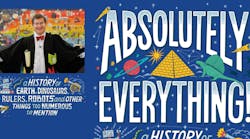At a time when companies are fighting for STEM and hands-on skills, it is important to excite a younger generation to become scientifically literate. A while ago, I received a copy of Christopher Lloyd’s book Absolutely Everything!: A History of Earth, Dinosaurs, Rulers, Robots, and Other Things Too Numerous to Mention. (What on Earth? Books). The former science correspondent for The Sunday Times, Lloyd is a historian, educationalist, and a bestselling author known for presenting the history of the world to a younger audience. While I’ve seen other science books geared toward a younger generation, Lloyd has an interesting technique for presenting information.
Traditionally, we may be more familiar with learning a topic by starting from a broad perspective and then zooming in. Our schools traditionally follow this approach; as we progress and gain expertise on a subject, the focus is narrowed. However, today we seem to be moving further from this idea. As industry introduces more automation, Internet of Things, and artificial intelligence, we seem start with one “thing”, then zoom out to see how everything is connected.
This is one thing—among others—Lloyd is known for. In his new book, he takes a comprehensive look at the history of earth, from the Big Bang to the ways in which we can shape the future, for reader ages 10 to 14.
As mentioned, scientific literacy is important. Many institutions are working to inspire interest in science, technology, engineering, and mathematics (STEM) among youth. To try and fit such a wide scope of information into a single book, Lloyd used a logarithm, informative pictures, and color coding to organize it and keep young students’ attention.
The first thing I liked about Lloyd’s presentation was he understood that often when conveying information on a massive scale that logarithms can be wonderful things. Some historians and writers aren’t aware of their power, but you can scale the importance of a lot of data and it’s impact on current time, seeing it all in one graph. This lets you see multiple things happening at the same time. If you haven’t seen Lloyd’s TED Talk, he does a great job of explaining this with a large graph that takes everything from the big bang to today.
These informative images are throughout the book and help readers retain information visually. However, how can you develop multiple timelines at once? This is where Lloyd uses color coding and chapters that overlap time lines to stich everything together in an easy-to-follow process. The only time I’ve personally seen anyone try to tackle such a task was Bill Bryson’s A Short History of Nearly Everything—another great read I suggest getting (although Bryson’s book is geared more toward adults).
By overlapping timelines with chapters like “Meanwhile, in Asia”, Lloyd effectively shows how the Earth progressed on multiple continents and how things are connected. As the book moves into the modern age the chapters evolve into how industry became global, how war changed the world, and how inventions alter our perceptions.
This is a short review of a long book that summarizes everything we know, yet by tailoring technical writing to a younger audience, is easy to follow and learn from. I recommend checking out this book for any young person in your life…and while you’re at it, a copy of Bryson’s book for yourself.

